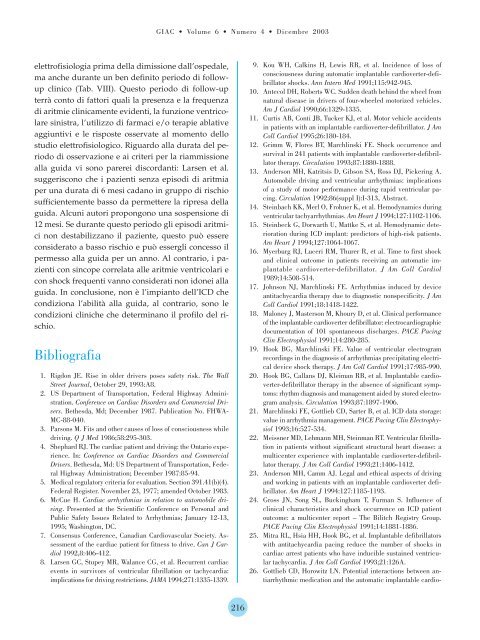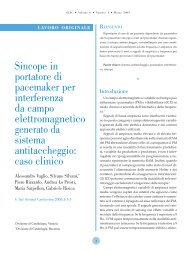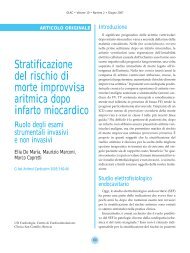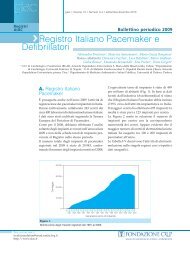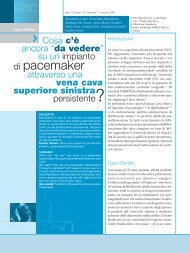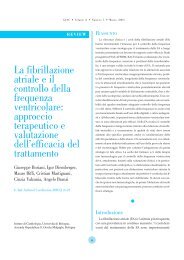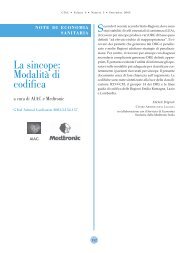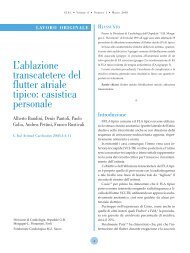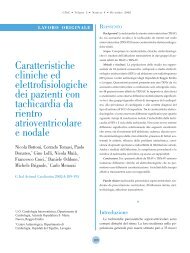Quali implicazioni per la guida nel paziente con sincope? - Giornale ...
Quali implicazioni per la guida nel paziente con sincope? - Giornale ...
Quali implicazioni per la guida nel paziente con sincope? - Giornale ...
You also want an ePaper? Increase the reach of your titles
YUMPU automatically turns print PDFs into web optimized ePapers that Google loves.
GIAC • Volume 6 • Numero 4 • Dicembre 2003elettrofisiologia prima del<strong>la</strong> dimissione dall’ospedale,ma anche durante un ben definito <strong>per</strong>iodo di followupclinico (Tab. VIII). Questo <strong>per</strong>iodo di follow-upterrà <strong>con</strong>to di fattori quali <strong>la</strong> presenza e <strong>la</strong> frequenzadi aritmie clinicamente evidenti, <strong>la</strong> funzione ventrico<strong>la</strong>resinistra, l’utilizzo di farmaci e/o terapie ab<strong>la</strong>tiveaggiuntivi e le risposte osservate al momento dellostudio elettrofisiologico. Riguardo al<strong>la</strong> durata del <strong>per</strong>iododi osservazione e ai criteri <strong>per</strong> <strong>la</strong> riammissioneal<strong>la</strong> <strong>guida</strong> vi sono parerei discordanti: Larsen et al.suggeris<strong>con</strong>o che i pazienti senza episodi di aritmia<strong>per</strong> una durata di 6 mesi cadano in gruppo di rischiosufficientemente basso da <strong>per</strong>mettere <strong>la</strong> ripresa del<strong>la</strong><strong>guida</strong>. Alcuni autori propongono una sospensione di12 mesi. Se durante questo <strong>per</strong>iodo gli episodi aritmicinon destabilizzano il <strong>paziente</strong>, questo può essere<strong>con</strong>siderato a basso rischio e può essergli <strong>con</strong>cesso il<strong>per</strong>messo al<strong>la</strong> <strong>guida</strong> <strong>per</strong> un anno. Al <strong>con</strong>trario, i pazienti<strong>con</strong> <strong>sincope</strong> corre<strong>la</strong>ta alle aritmie ventrico<strong>la</strong>ri e<strong>con</strong> shock frequenti vanno <strong>con</strong>siderati non idonei al<strong>la</strong><strong>guida</strong>. In <strong>con</strong>clusione, non è l’impianto dell’ICD che<strong>con</strong>diziona l’abilità al<strong>la</strong> <strong>guida</strong>, al <strong>con</strong>trario, sono le<strong>con</strong>dizioni cliniche che determinano il profilo del rischio.Bibliografia1. Rigdon JE. Rise in older drivers poses safety risk. The WallStreet Journal, October 29, 1993:A8.2. US Department of Transportation, Federal Highway Administration.Conference on Cardiac Disorders and Commercial Drivers.Bethesda, Md; December 1987. Publication No. FHWA-MC-88-040.3. Parsons M. Fits and other causes of loss of <strong>con</strong>sciousness whiledriving. Q J Med 1986;58:295-303.4. Shephard RJ. The cardiac patient and driving: the Ontario ex<strong>per</strong>ience.In: Conference on Cardiac Disorders and CommercialDrivers. Bethesda, Md: US Department of Transportation, FederalHighway Administration; December 1987:85-94.5. Medical regu<strong>la</strong>tory criteria for evaluation. Section 391.41(b)(4).Federal Register. November 23, 1977; amended October 1983.6. McCue H. Cardiac arrhythmias in re<strong>la</strong>tion to automobile driving.Presented at the Scientific Conference on Personal andPublic Safety Issues Re<strong>la</strong>ted to Arrhythmias; January 12-13,1995; Washington, DC.7. Consensus Conference, Canadian Cardiovascu<strong>la</strong>r Society. Assessmentof the cardiac patient for fitness to drive. Can J Cardiol1992,8:406-412.8. Larsen GC, Stupey MR, Wa<strong>la</strong>nce CG, et al. Recurrent cardiacevents in survivors of ventricu<strong>la</strong>r fibril<strong>la</strong>tion or tachycardia:implications for driving restrictions. JAMA 1994;271:1335-1339.9. Kou WH, Calkins H, Lewis RR, et al. Incidence of loss of<strong>con</strong>sciousness during automatic imp<strong>la</strong>ntable cardioverter-defibril<strong>la</strong>torshocks. Ann Intern Med 1991;115:942-945.10. Antecol DH, Roberts WC. Sudden death behind the wheel fromnatural disease in drivers of four-wheeled motorized vehicles.Am J Cardiol 1990;66:1329-1335.11. Curtis AB, Conti JB, Tucker KJ, et al. Motor vehicle accidentsin patients with an imp<strong>la</strong>ntable cardioverter-defibril<strong>la</strong>tor. J AmColl Cardiol 1995;26:180-184.12. Grimm W, Flores BT, Marchlinski FE. Shock occurrence andsurvival in 241 patients with imp<strong>la</strong>ntable cardioverter-defibril<strong>la</strong>tortherapy. Circu<strong>la</strong>tion 1993;87:1880-1888.13. Anderson MH, Katritsis D, Gibson SA, Ross DJ, Pickering A.Automobile driving and ventricu<strong>la</strong>r arrhythmias: implicationsof a study of motor <strong>per</strong>formance during rapid ventricu<strong>la</strong>r pacing.Circu<strong>la</strong>tion 1992;86(suppl I):I-313, Abstract.14. Steinbach KK, Merl O, Frohner K, et al. Hemodynamics duringventricu<strong>la</strong>r tachyarrhythmias. Am Heart J 1994;127:1102-1106.15. Steinbeck G, Dorwarth U, Mattke S, et al. Hemodynamic deteriorationduring ICD imp<strong>la</strong>nt: predictors of high-risk patients.Am Heart J 1994;127:1064-1067.16. Myerburg RJ, Luceri RM, Thurer R, et al. Time to first shockand clinical outcome in patients receiving an automatic imp<strong>la</strong>ntablecardioverter-defibril<strong>la</strong>tor. J Am Coll Cardiol1989;14:508-514.17. Johnson NJ, Marchlinski FE. Arrhythmias induced by deviceantitachycardia therapy due to diagnostic nonspecificity. J AmColl Cardiol 1991;18:1418-1422.18. Maloney J, Masterson M, Khoury D, et al. Clinical <strong>per</strong>formanceof the imp<strong>la</strong>ntable cardioverter defibril<strong>la</strong>tor: electrocardiographicdocumentation of 101 spontaneous discharges. PACE PacingClin Electrophysiol 1991;14:280-285.19. Hook BG, Marchlinski FE. Value of ventricu<strong>la</strong>r electrogramrecordings in the diagnosis of arrhythmias precipitating electricaldevice shock therapy. J Am Coll Cardiol 1991;17:985-990.20. Hook BG, Cal<strong>la</strong>ns DJ, Kleiman RB, et al. Imp<strong>la</strong>ntable cardioverter-defibril<strong>la</strong>tortherapy in the absence of significant symptoms:rhythm diagnosis and management aided by stored electrogramanalysis. Circu<strong>la</strong>tion 1993;87:1897-1906.21. Marchlinski FE, Gottlieb CD, Sarter B, et al. ICD data storage:value in arrhythmia management. PACE Pacing Clin Electrophysiol1993;16:527-534.22. Meissner MD, Lehmann MH, Steinman RT. Ventricu<strong>la</strong>r fibril<strong>la</strong>tionin patients without significant structural heart disease: amulticenter ex<strong>per</strong>ience with imp<strong>la</strong>ntable cardioverter-defibril<strong>la</strong>tortherapy. J Am Coll Cardiol 1993;21:1406-1412.23. Anderson MH, Camm AJ. Legal and ethical aspects of drivingand working in patients with an imp<strong>la</strong>ntable cardioverter defibril<strong>la</strong>tor.Am Heart J 1994:127:1185-1193.24. Gross JN, Song SL, Buckingham T, Furman S. Influence ofclinical characteristics and shock occurrence on ICD patientoutcome: a multicenter report – The Bilitch Registry Group.PACE Pacing Clin Electrophysiol 1991;14:1881-1886.25. Mitra RL, Hsia HH, Hook BG, et al. Imp<strong>la</strong>ntable defibril<strong>la</strong>torswith antitachycardia pacing reduce the number of shocks incardiac arrest patients who have inducible sustained ventricu<strong>la</strong>rtachycardia. J Am Coll Cardiol 1993;21:126A.26. Gottlieb CD, Horowitz LN. Potential interactions between antiarrhythmicmedication and the automatic imp<strong>la</strong>ntable cardio-216


